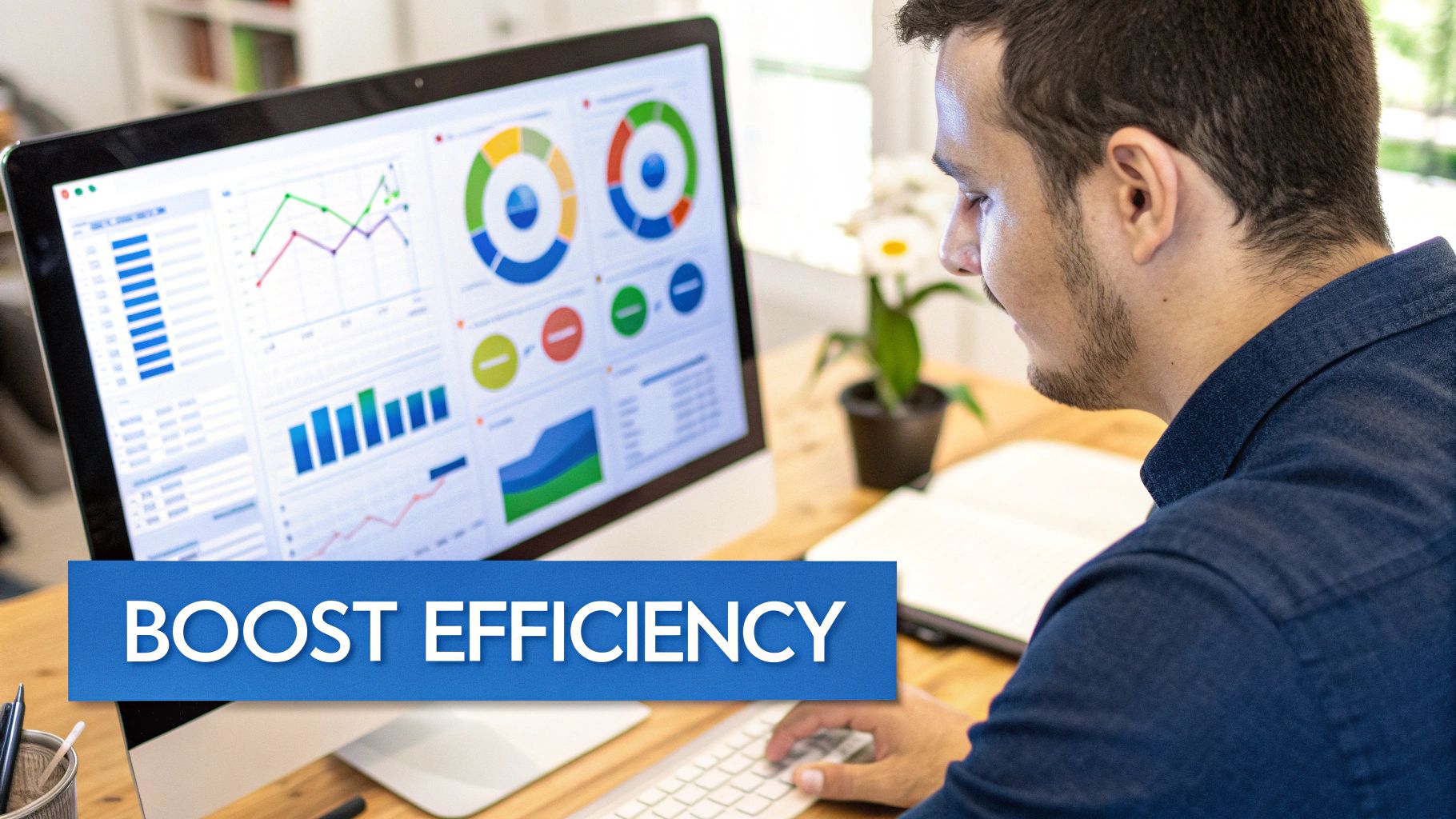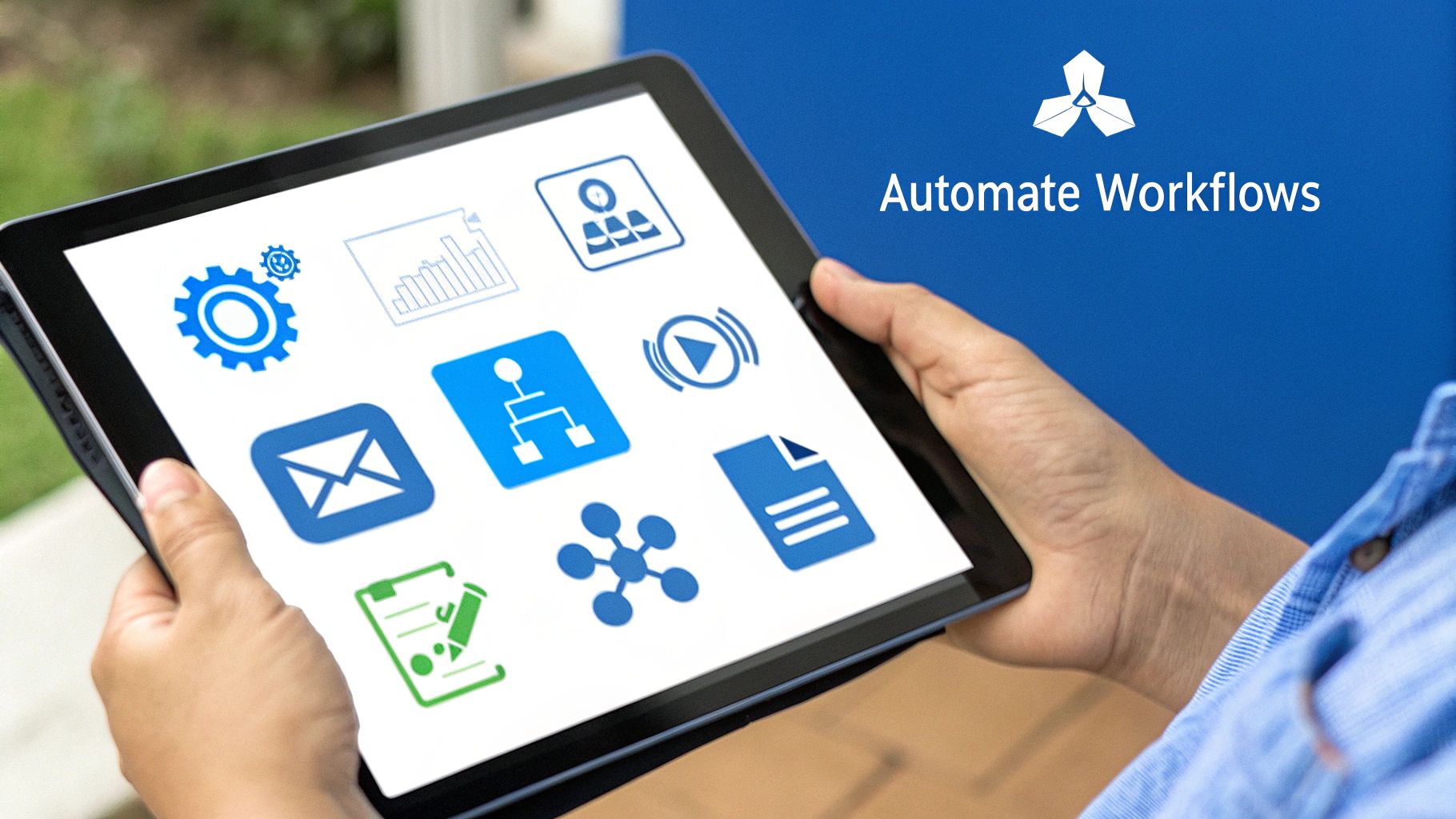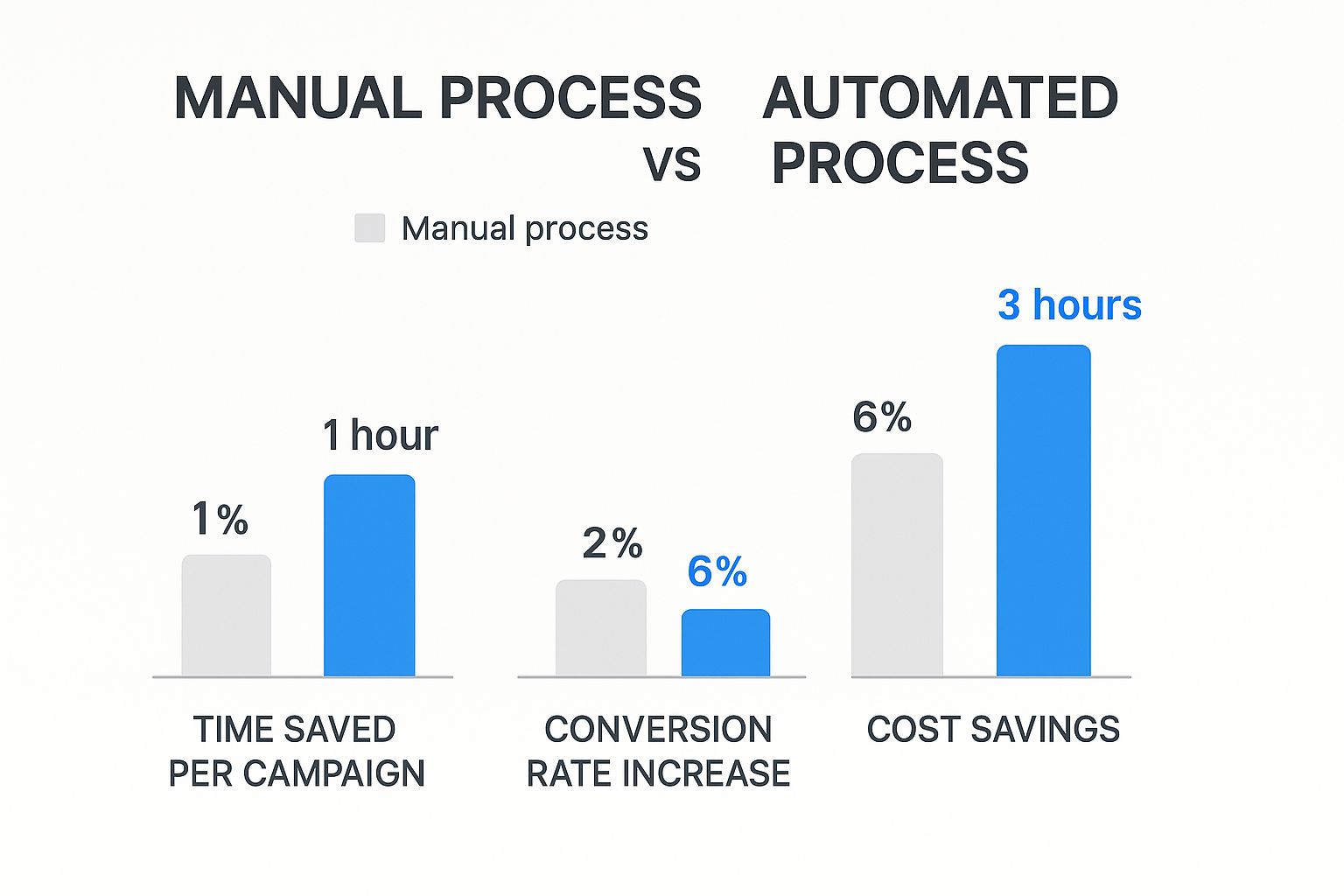Marketing automation isn't just a fancy software category; for agencies, it's a lifeline. It’s the engine that automates the repetitive, time-sucking marketing tasks, helps you dial in your workflows, and finally gives you a clear way to measure campaign results across your entire client roster. Think of it less as a tool and more as a strategic partner for growth—one that allows you to scale your operations, prove ROI, and free up your team to focus on creative work instead of getting bogged down in manual processes.

Let's be honest, running a marketing agency is a constant juggling act. You’re trying to keep demanding clients happy, chase new business, and prove your worth—all while battling tight resources and even tighter deadlines. It’s a grind, and it often feels like you need more hours in the day just to keep the wheels on.
This is exactly where marketing automation for agencies comes in. It's not another complicated tool to add to your tech stack; it’s a fundamental shift in how you operate. Picture it as a world-class production manager for your agency, flawlessly coordinating every moving part behind the scenes so you don't have to.
This system works tirelessly 24/7, handling everything from client onboarding sequences to sophisticated lead nurturing campaigns. It ensures no lead ever falls through the cracks and every client receives timely, personalized communication—without your team lifting a finger for each individual action.
The true magic of automation is its ability to shatter growth ceilings. As your client roster expands, those manual processes that used to work just fine suddenly become major bottlenecks. Automation blows those limitations away, letting you deliver sophisticated, personalized campaigns at scale. You can manage ten clients with the same efficiency and sharp attention to detail as you would one.
This operational advantage translates directly into a better client experience and, ultimately, a healthier bottom line. The benefits are real and immediate:
By automating routine processes, agencies reclaim a massive amount of time. In fact, some reports show that 93% of marketers now use AI-powered automation to produce content and analyze campaign data faster than ever before.
At the end of the day, implementing marketing automation transforms your agency’s entire role. You stop being just another service provider executing tasks and become a strategic partner who delivers predictable, measurable growth. You’ll have the insights to anticipate what your clients need next and the operational muscle to exceed their expectations every time.
To see exactly how these systems are built from the ground up, check out our detailed guide on marketing workflow automation. It provides a clear, actionable roadmap to transform your agency's operations and secure its long-term success.

Terms like "workflows" and "triggers" get thrown around a lot, and honestly, they can sound a little intimidating. But the ideas behind them are surprisingly simple—and powerful. Instead of getting bogged down in jargon, let's walk through a real-world agency scenario to see how these pieces click together.
Imagine your client, a B2B software company, gets a new lead from a webinar registration form. That single form submission is the trigger. Think of it as the starting pistol in a race. It’s the one specific event that tells the automation system, "Okay, it's time to go!"
Once that trigger fires, it kicks off a pre-built workflow, which is nothing more than a series of automated actions. A workflow is like a digital assembly line you’ve already designed. The system doesn't need a human to step in and decide what to do next; it just follows the path you’ve mapped out.
The first step in this B2B client’s workflow might be to instantly send a personalized thank-you email. At the same exact time, the system can add that new contact to a specific segment—let's call it "Webinar Leads - Tech Prospects." This is huge because segmentation allows you to send super-targeted follow-ups that actually resonate with their interests.
From there, the workflow keeps going. A few days later, it might send another email with a case study relevant to their industry. But the workflow is smart; it’s built with "if/then" logic. For example: if the lead clicks the link to the case study, the system can automatically tag them as "Engaged" and send a more product-focused email next. If they don't click, it might send a gentler reminder or a different piece of content entirely.
This all happens on its own, ensuring every single lead gets immediate, relevant, and consistent communication, no matter when they sign up.
A workflow is the heart of marketing automation for agencies. It’s not just one action; it’s a strategic, multi-step journey you design for your client’s contacts, triggered by their specific behaviors.
As the prospect keeps interacting with your client’s content, another powerful tool comes into play: lead scoring. This feature quietly assigns points to contacts based on what they do. Opening an email might be worth 1 point, clicking a link could be 5 points, and visiting the pricing page could add a whopping 15 points.
This scoring system works silently in the background, qualifying leads based on how interested they actually are. When a lead's score hits a certain threshold you’ve set—say, 50 points—it signals that they’re highly engaged and probably ready for a sales conversation.
At this point, the workflow can execute its final, most important actions:
These core tools—triggers, workflows, segmentation, and lead scoring—all work together to create a completely seamless handoff from marketing to sales. By connecting these systems, you build a reliable machine that not only nurtures leads but also proves its value by delivering qualified opportunities right to your client’s sales team. To get a better sense of how these systems talk to each other, you can explore the various marketing automation integrations available that make this possible.

Generic promises of "efficiency" don't mean much. For an agency, the real power of marketing automation is its ability to create tangible, measurable wins—for your own operations and for your clients' bottom lines. Let's get past the buzzwords and look at the three core areas where automation truly delivers.
These aren't just theoretical perks. They represent a fundamental shift in how your agency operates, scales, and keeps clients coming back. Master them, and you’ll build a far more profitable and sustainable business.
Every agency eventually hits a wall. A point where adding one more client means hiring another person just to keep up with the manual grind. Automation completely shatters that ceiling by taking over the repetitive, soul-crushing tasks that drain your team's energy and your profit margins.
Think about the hours your account managers spend manually pulling data for monthly performance reports. Now imagine that entire process happening automatically. Or picture a polished, automated welcome campaign that fires off the second a new client lead comes in, making a perfect first impression without anyone lifting a finger. This is what practical marketing automation for agencies looks like.
Once you offload those tasks, your talented team members are free to focus on high-value, strategic work—the kind of work clients are more than happy to pay a premium for. This lets you:
The single most powerful way to keep a client is to prove, with cold, hard data, that your work is making them money. Automation gives you the tools to draw a straight, undeniable line from your marketing campaigns to your client’s sales revenue. It's the ultimate proof of your value.
With closed-loop reporting, automation platforms connect marketing touchpoints—like email clicks or form fills—directly to sales outcomes in a CRM. You can literally show a client how a specific blog post or email sequence generated leads that turned into paying customers.
This is the move that separates a disposable vendor from an indispensable partner. You stop reporting on vanity metrics like "likes" and start showing them concrete business results like "revenue influenced."
This capability is changing the game for agency-client relationships. For instance, some agencies are now building much stronger client trust and cutting down optimization time by using AI-powered attribution tools. You can read more about how Rise Up Marketing builds client trust and cuts optimization time with Cometly AI.
Finally, automation transforms your agency from a task-doer into an essential strategic advisor. The data collected by these platforms gives you deep insights into customer behavior, allowing you to spot new growth opportunities for clients before they even think to ask.
You can see which content is resonating with their highest-value leads or pinpoint exactly where friction in the customer journey is causing people to drop off. When you walk into a client meeting armed with these data-backed insights, the conversation shifts from tactical updates to high-level strategic planning.
This data-driven approach is fueling massive industry growth. The marketing automation market is on track to be worth $15.6 billion globally by 2025, with businesses seeing an average return of $5.44 for every dollar they invest.
A huge part of this is how automation helps bolster customer retention for your clients. By understanding and serving customers better, you not only improve their business but also lock in your agency’s role as a critical partner in their success. To go deeper on this, it's worth exploring different customer retention management strategies.
Picking a marketing automation platform is a lot like choosing the foundation for a new house. Get it right, and you can build a stable, scalable structure for your agency and every client you serve. But if you get it wrong? You'll be dealing with costly cracks and frustrating limitations down the road. The market is packed with options, but you can cut through the noise by focusing on what actually matters to an agency.
It’s easy to get distracted by flashy features built for in-house teams. Your evaluation needs to be laser-focused on agency-specific needs. This means looking past the basic email builders and workflow creators. Your success really hinges on the platform’s ability to manage multiple clients with ease, represent your brand professionally, and slot perfectly into your existing tech stack.
This infographic breaks down the clear advantages of an automated process over a manual one, highlighting the real-world benefits you can expect from making the right choice.

As you can see, automation delivers major gains in efficiency, performance, and cost-effectiveness for every single campaign you run.
When you start scheduling demos, walk in with a clear checklist of your non-negotiables. Generic platforms designed for a single business just can't handle the unique demands of an agency. The goal is to find a tool that makes your life easier, not one that forces you into clunky workarounds.
Here are the critical capabilities to look for:
A platform that can’t integrate with your core tools creates data silos and manual work, defeating the very purpose of automation. Your goal is a unified system, not another isolated piece of software.
Your agency is built to grow, and your marketing automation platform needs to keep up. This means looking beyond the feature list to the pricing structure and support system. A tool that seems like a bargain today could become a huge expense as you add clients or their contact lists expand.
Look for pricing models that are agency-friendly. This usually means plans based on the total number of contacts across all your accounts, or tiered packages that unlock features as you scale. Steer clear of platforms with rigid, per-seat pricing that penalizes you for growing your team. For larger needs, it's worth considering enterprise solutions like HubSpot as a potential platform, which offers a comprehensive suite for marketing, sales, and service.
To help you narrow down the options, we've put together a quick comparison of some of the top platforms, focusing on the features that matter most to agencies like yours.
This table should give you a starting point, but always dig deeper into the specifics of each platform to ensure it aligns perfectly with your agency's model and your clients' needs.
The market is definitely shifting. In 2024, while large enterprises held 62.5% of marketing automation revenue, smaller businesses showed the fastest growth. This is largely thanks to more accessible platforms offering freemium models and easy-to-use interfaces—perfect for agencies serving a wide range of clients.
Ultimately, the best marketing automation for agencies comes down to your specific client mix and growth plans. For a complete look at the top contenders, check out our guide on the top 10 best marketing automation platforms for 2025.
Buying a powerful marketing automation platform is a lot like getting a top-of-the-line kitchen for a new restaurant. It’s an impressive first step, but the tools alone don’t guarantee success. The real magic comes from the strategy and execution—the recipes that turn great ingredients into amazing results. For your agency, that means having a repeatable, scalable plan is what will truly deliver for your clients.
The biggest mistake you can make is trying to automate everything at once. This "boil the ocean" approach almost always ends in overly complicated workflows that are a nightmare to manage and even harder to measure. The smarter path? Start by banking a few quick, high-impact wins to build momentum and show the client immediate value.
This proves the concept right out of the gate and builds a solid foundation you can layer more complex strategies on top of over time.
The best place to kick things off is with automations that are high-impact but low-effort. Think of these as the workhorses—simple to set up, but they produce significant, measurable results right away. This approach builds client confidence and gives your team a chance to master the platform's core functions without getting overwhelmed.
Focus on these "early win" campaigns first:
By focusing on these core automations, you establish a baseline of success. You’re not just installing software; you're building a reliable system that generates predictable outcomes, which is exactly what clients are paying you for.
Before you even think about building your first workflow, you have to get the groundwork right. Skipping this step is like trying to build a house on a shaky foundation—it’s guaranteed to cause problems down the road. A little prep work ensures your automation efforts are effective and scalable from the get-go.
This foundational work boils down to three critical components:
Once your foundational automations are humming along and delivering results, it's time to add more advanced layers. This is where you can really flex your agency's strategic muscle. These next-level tactics use behavioral data to create deeply personalized experiences that drive much higher engagement and conversions.
Consider layering in these strategies:
Recent surveys show that while 98% of B2B marketers see marketing automation as essential, only about 41% have fully automated their customer journey. The most common starting point is email automation, adopted by 58% of marketers. You can learn more about the latest automation statistics and trends to see how your strategies stack up. This gap between perceived value and full implementation highlights a massive opportunity for agencies that can master a strategic, phased rollout.
Jumping into marketing automation always brings up a ton of practical questions. This is especially true for agency leaders juggling their own operations and their clients' success. It's totally normal to wonder about pricing, what skills your team needs, and how you're going to prove this whole thing is worth the investment.
Think of this section as your field guide. We're skipping the high-level theory and digging into the real-world stuff you'll face when you start rolling this out. The goal is to give you clear, straightforward answers so you can feel confident in your strategy from day one.
Pricing automation services can feel a little tricky, but it really just boils down to matching your fees to the value you deliver. The big idea is to stop charging for your time and start charging for the results you create. Most successful agencies land on one of three models.
A lot of agencies simply bundle automation into a comprehensive monthly retainer. The price tag reflects how complex the workflows are, the size of the client's contact list, and how much hands-on strategy you're providing. This model gives you predictable revenue and the client a clear, fixed cost.
Another great option is a one-time project fee to cover the initial heavy lifting—the strategy mapping, setup, and campaign build-out. After that initial project, you can switch to a smaller monthly fee for management and optimization. This works really well for clients who need a big, foundational system built from scratch.
Finally, there's the performance-based model. This approach ties your fee directly to hitting specific KPIs you both agree on. You might get paid per marketing-qualified lead (MQL) you generate or take a percentage of the revenue your automated campaigns influence. This model shows you have ultimate skin in the game and turns the relationship into a true partnership.
No matter which model you choose, the key is radical transparency. You have to clearly spell out the scope of work—how many campaigns, the depth of your reporting, the strategic support included—to show undeniable value and justify every single dollar.
You don't need to go out and hire a whole new department to nail automation. Instead, it’s about having the right mix of three core talents. Chances are, you already have these skills on your team—they just need to be focused in the right direction.
First, you need a technical specialist. This is the person who actually enjoys building workflows, keeping data clean, and wrestling with tricky integrations. They're the ones making sure the engine is running smoothly behind the scenes.
Second, you need a strategist. This person is the architect of the entire customer journey. They map out the campaign logic, decide how to segment audiences, and make sure every automated touchpoint aligns perfectly with the client's business goals. They answer the "why" behind everything you do.
Third, you need a creative storyteller. This is your copywriter and content creator, the one crafting the emails, landing page copy, and offers that make the whole system work. Their words are what make the automation feel human and compelling, not robotic.
These roles can be separate, but the one skill everyone on the team absolutely must have is analytical thinking. The ability to look at performance data, figure out what it's telling you, and make smart, evidence-based tweaks to the campaigns is what separates a good automation team from a great one.
This is a classic "it depends" situation, but the answer really comes down to your client's current tech stack and what they want to achieve long-term. Many modern marketing automation platforms, like HubSpot, are powerful all-in-one systems. They come with a built-in CRM and strong email marketing tools, which means you can often consolidate a handful of different tools into a single platform.
This all-in-one approach is incredibly efficient. It creates one source of truth for all your data, giving you that complete, 360-degree view of the customer that’s so valuable for personalization and reporting. For a lot of clients, especially those with clunky, disconnected systems, making the switch is the right move.
However, if your client is already deeply invested in a specialized CRM like Salesforce, trying to rip and replace it is usually a huge mistake. In those cases, the smarter play is to pick a marketing automation platform that integrates seamlessly with their existing CRM. The right choice always comes after a careful look at your client's current tech, business processes, and future goals. To learn more about how these systems can work together, check out this guide on how automation can streamline your marketing efforts and save time.
This is where marketing automation truly shines. When you do it right, it becomes your agency's single most powerful tool for client retention. The secret is using the platform's built-in reporting to draw a straight, undeniable line from your marketing activities directly to your client's revenue.
Before you even think about launching a campaign, sit down with the client and agree on the metrics that actually matter to their business. This could include:
Once you’ve agreed on the KPIs, you can build reports in your automation platform that show the entire funnel in plain sight. You’ll be able to walk into a meeting and say: "We generated X leads from this campaign, nurtured Y of them with these automated workflows, and that resulted in Z new customers and $XX,XXX in revenue."
When you tie your work directly to bottom-line results, you completely change the conversation. Marketing stops being a "cost center" and becomes what it should be: a predictable revenue generator.
Ready to eliminate wasted ad spend and prove your agency's true impact? Cometly provides a unified attribution platform that tracks every touchpoint, giving you the clarity needed to optimize campaigns and scale client growth with confidence. Get started with Cometly today!
Learn how Cometly can help you pinpoint channels driving revenue.
.svg)
Network with the top performance marketers in the industry